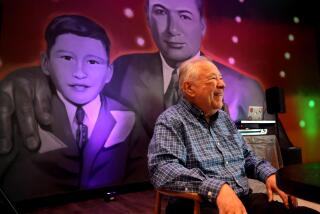Los Angeles Theater: Flashback to yesteryear . . . and a Latino renaissance on Broadway
I went back in time the other day to see inside the Los Angeles Theater, at 625 S. Broadway.
The Los Angeles was the last of the great motion picture palaces built on Broadway. It was completed in 1931. Today it is queen of the 13 houses that remain in operation on Broadway between 3rd and 9th streets.
I was invited on my nostalgic tour by Archie Herzoff, director of public relations for Metropolitan Theatres Corp., which owns and operates them all.
It is the only large concentration of vintage movie theaters left in America.
As a high school boy, when I lived only a mile from Broadway, I used to spend Saturdays in those theaters. For 15 cents you could see three features. I have no doubt that I have been in every one of them--Palace, Arcade, Broadway, Orpheum, Cameo, State, Rialto, Tower, Roxie, Olympic, United Artists, Million Dollar and Los Angeles.
I remember walking into those opulent interiors, surrounded by the glory of the Renaissance, or the age of Baroque, and spending two or three hours in the dream world of the movies. When I came out again the sky blazed; the heat bounced off the sidewalk; traffic sounds filled the street; I was back in the hard reality of the Depression.
I walked south on Broadway past the Million Dollar Theater, at 3rd Street. It was built in 1917 and named for its cost. The Spanish titles on the marquee today attest to the changing ethnic nature of the street. So do the names of popular idols embedded in the sidewalk--Pedro Infante, Cantinflas, Pedro Armendariz, Jorge Negrete.
At 4th Street the empty shell of the old Broadway store also bears witness to the changing demographics. From 3rd to 9th the street is entirely Latinized. It might be a street in the heart of Mexico. Mexican music blasts out to the sidewalk from stereo shops. Taco stands abound. Merchants roll their wares out to the sidewalk on racks--clothing, jewelry, leather goods, shoes. All the signs are either in Spanish or bilingual.
Broadway obviously had been rescued and revitalized by the Spanish-speaking population.
Herzoff was waiting for me inside the theater doors with three executives of the corporation: Danny Hernandez and Leonardo Ledesma, downtown district managers, and Morton Lippe, head film buyer and booker, who had started with Metropolitan as an usher in 1940. (The survival of the Metropolitan theaters is owed to three generations of one family. Joseph H. Corwin, an Iowa theater owner who bought the Broadway theater in 1923; his son, Sherrill, and Sherrill’s son, Bruce C. Corwin, and his twin sister, Bonnie Fuller.)
I remarked that it was the first time I had ever got into the Los Angeles Theater free.
Lippe talked my language. After high school I had been an usher at the Stadium on Pico. It is now a synagogue. “I made $17 a week,” I recalled.
“You were rich,” said Lippe. “I made $11 a week to start. They put an ad in the paper for seven jobs. Three hundred applicants turned up. I didn’t have any of the qualifications, but I got a job.”
I said I had had to spend one Saturday morning on a ladder changing light bulbs in the chandelier, and after that I quit. “Yes,” he said, “we used to have to wipe every bulb off and screw it back in.”
The Los Angeles was ornate and opulent beyond my memories. Like the Million Dollar, it had cost a million. It opened in 1931 for the premiere of Charles Chaplin’s “City Lights.” Its lobby suggests nothing less than the glory of Versailles. The space is enclosed with mirrors and ornamented with colossal marble columns, bronze banisters and sumptuous chandeliers.
The auditorium itself is crowned by an ornate ceiling with trompe l’oeil murals. Backlighted classic sculptures stand in sidewall niches. It is palatial beyond the dreams of a prince.
But its triumph is downstairs. A sign of recent vintage says, “Banos. Damas y Caballeros. Abajo.” (Bathrooms. Ladies and Gentlemen. Downstairs.)
First one enters a grand lounge. Oval-shaped and as big as a basketball court. “This used to be lined with Louis XVI chairs,” Lippe recalled.
The lounge leads into the ladies’ powder room, which is lined with mirrors and dressers, and then into a long room lined by toilet stalls on either side--each stall done in a different kind of marble and each toilet bowl of a different pastel shade. Pink. Jade. Beige. Blue. It was elegant beyond any such facility I had seen.
Almost all the patrons of the Los Angeles and its sister theaters are Spanish-speaking, but the Los Angeles, State, Palace, Tower, Rialto and Cameo show American movies without subtitles.
“Latinos love American films,” Hernandez explained. “In Mexico, 70% of the theaters show American films.”
He said 50% of their patrons come downtown by bus.
“On Sundays,” Lippe said, “they bring the whole family. There’s no such thing as a baby sitter.”
He recalled that the Los Angeles had been dark for years during the Depression, but in the war years it became a favorite with soldiers and sailors. “It was open from 8 a.m. to 6 a.m. We closed two hours just to clean up. We took in big money. At 85 cents and $1 a seat we would take in $30,000 a week.’
“Then, in the ‘50s, the bottom dropped out. The baby boom. Drive-ins. People moved to the suburbs.”
And of course TV came along.
Today the Latino renaissance has brought it back.
More to Read
The biggest entertainment stories
Get our big stories about Hollywood, film, television, music, arts, culture and more right in your inbox as soon as they publish.
You may occasionally receive promotional content from the Los Angeles Times.










